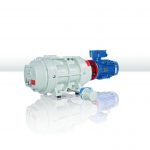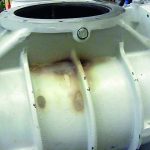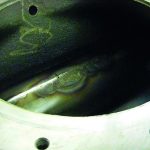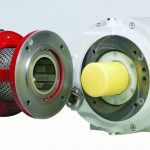When choosing an ideal vacuum solution, price tends to be one of the most important considerations. However, prioritising price over performance and quality more often than not means buying a pump with a shorter service life and one that, in the long run, will generate higher maintenance costs than a better quality pump. This can easily be avoided by following a few simple rules regarding different pump types when choosing and operating a vacuum pump. The most important information on using Roots pumps is described here.
Roots pumps operate on a purely volumetric basis; unlike rotary vane pumps, they do not use internal compression but instead compress against exhaust pressure. All parts that come into contact with media are oil-free. This is why Roots pumps are also called dry pumps. They are distinguished by their compact design and high pumping speed. Pfeiffer Vacuum has taken Roots pump technology to a new level and now manufactures magnetically coupled versions. Oktaline Atex vacuum pumps are designed for use in explosive environments and for evacuating explosive gases.
They are available as category 2 and 3 equipment to cover various applications. All pumps are suitable for temperature class T3. The operating principle of these successful Roots pumps has been further enhanced by the addition of a magnetic coupling. This means that the pumps are hermetically sealed and have very low leakage rates of less than 1×10-6 Pa m3/s. Thanks to the magnetic coupling, there is no longer any need for shaft seals, which are inherent weak points when it comes to pressure surges and are also high-maintenance. Oktaline Atex pumps can withstand pressure surges up to 1600 kPa and, due to the magnetic coupling, there is no risk of zone entrainment. All pumps in the Atex series have a pumping speed range between 280 to 5190 m³/h. The gearbox and bearings in these Roots pumps are separated from the gas pumping chamber. The frictionless pumping action of the Roots pumps means that they are technically dry in terms of operation. These pumps also benefit from an air cooling system, which is associated with significantly lower operating costs than water-based ones.
Requirements for a long service life
Roots pumps can only operate reliably if they are perfectly matched to their respective requirements and operated in line with a few important rules. However, quite frequently, the parameters applied when choosing and operating vacuum pumps are not consistent with the demands placed on them, hence leading to a shorter service life – something that can easily be prevented. It is not recommended, for example, to switch a Roots pump that is running on maximum differential pressure directly over to final vacuum conditions without cooling it down first. This is because in final vacuum the minimal or zero gas throughput means that heat cannot be dissipated quickly via the gas or through the casing surface. Due to the sudden rise in temperature, the gap between the rotor and the casing becomes extremely small, causing the rotors to start up the pump. In extreme cases, this leads to a total failure.
Sudden steep drops in the ambient temperature result in the pump casing contracting while the Roots pistons are still hot, thereby also starting up the pump. This is particularly dangerous when operating in final vacuum. Temperature shocks like this must be avoided at all costs. In addition, the operator must take care that rolling shutters or other doors in the vicinity are not opened suddenly, especially in the winter, and that free-standing pumps are protected by a roof or canopy from rain that may cool them down. If, in case of fire, water were to be directly aimed at the pump, the casing could explode, especially that of the cast-iron model. The pump version in nodular cast iron is therefore better suited for this purpose due to the higher strength of the material.
Protected from overheating
If Roots pumps are operated in the region of their maximum differential pressure, a temperature sensor must be attached to the exhaust port to protect the pump from overheating. This generates a warning at a defined gas temperature and will turn the pump off when it reaches the maximum permitted temperature. Thermocouples are generally used to achieve this.
Some applications, such as the rapid evacuation of load locks, require very short cycle times of just a few seconds to be realised. In such cases, it is important that the gradation between the Roots pump and the backing pump is in a ratio of 2:1. This is necessary as most of the pumpdown work for evacuating the pump from atmospheric pressure to about 100 hPa is performed by the backing pump, and the Roots pump will only start to effectively contribute at around 10 hPa. The backing pump must have correspondingly large dimensions for this reason. In the case of multi-stage pumping stations or multiple parallel-operated pump combinations, it makes sense to turn on the pumps at staggered intervals, starting with the atmospheric pump, to prevent undue power spikes and cost-intensive circuit breakers. This staggered startup can easily be realised with a controller and PLC using a timing element. Another alternative is to start up the pump slowly with a frequency converter.
Avoiding fluid hammers
Sudden fluid hammers can destroy the pump: they cause it to cool down instantly because the gas is deprived of the heat needed to evaporate the liquid. The pump is consequently unable to pump out the extra vapour quickly enough because the backing pump will be overloaded and the fore-vacuum pressure may increase too sharply. To prevent this from happening, it is advisable to fit a condenser between the process chamber and the Roots pump. This will catch any fluid before it reaches the pump. During processes that generate particles and are laden with dust, it is useful to install dust filters on the suction side of the pump to protect both the Roots pump and the downstream pumps. To protect pumps against larger solids or from beads that could be emitted from the welds, a so-called splinter shield should be installed in the inlet ports of the Roots pump. These particles and solids can loosen themselves from welded joints when a system is evacuated for the first time if they have not been properly cleaned. In such a case, the use of original accessories from the manufacturer is recommended. This is because the splinter shield is designed in such a way that its free cross-section corresponds to the nominal size of the pump. This ensures that the pumping speed is not compromised by significant conductivity losses.
Pumpdown of critical gases
When pumping down expensive pure gases such as helium 3 and helium 4, an exchange with the ambient air during the process must be avoided at all costs. A high level of leak-tightness with a low leakage rate from the pump in the region of 10-5 to 10-8 hPa l/s is essential. Pfeiffer Vacuum offers a permanent magnetic coupling instead of the usual shaft feedthrough to the motor. This means that shaft sealing leaks are no longer an issue. With magnetic couplings, cost-efficient standard motors can be used. Magnetic couplings are available for Roots pumps with a capacity of up to 12,000 m3/h.
www.cpp-net.com search: cpp0117pfeiffervacuum
Heinz Barfuss
Product Manager, Pfeiffer Vacuum
Share:










